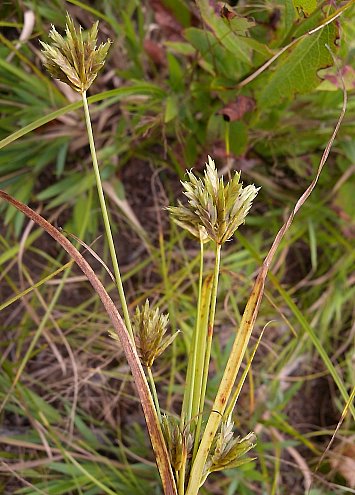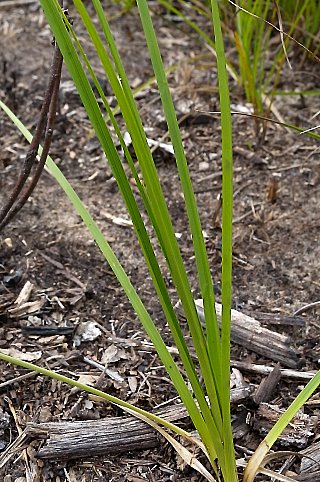
Each culm terminates in an inflorescence with 1-3 sessile floral spikes and 2-8 floral spikes on ascending to erect peduncles. The peduncles are 1-6" in length; they are stiff, straight, and glabrous (or nearly so). Each spike consists of a relatively broad obconic cluster of 8-20 spikelets. The spikelets in each cluster are ascending to erect. Each spikelet is ½-1" long, narrowly oblong in shape, and flattened, consisting of 5-18 perfect florets and their scales. In each spikelet, the floral scales are arranged in two columnar ranks; they are overlapping and ascending. Individual scales are 2.5-3.5 mm. in length, ovate in shape, glabrous, and sharply folded along their keels. The lateral sides of each scale have several fine veins. Each scale terminates in a short narrow tip up to 1.0 mm. in length (it is mucronate). At the bottom of each inflorescence, there are 3-6 leafy bracts of variable length (1-8" long); they are erect to ascending. These bracts resemble the leaf blades. The blooming period occurs during late summer to early fall. The florets are wind-pollinated. Shortly afterwards, fertile florets are replaced by achenes about 2.5-3.0 mm. long and 1.0 mm. across; these achenes are oblongoid in shape, slightly flattened, bluntly 3-angled, and hairless. At maturity, the achenes are light brown. The root system is fibrous and rhizomatous.
 Cultivation:
The preference is full sun, dry-mesic conditions, and sandy soil.
Because of its C4 metabolism, this sedge is slow to develop during the
growing season, although it is resistant to summer heat and drought.
Cultivation:
The preference is full sun, dry-mesic conditions, and sandy soil.
Because of its C4 metabolism, this sedge is slow to develop during the
growing season, although it is resistant to summer heat and drought.Range & Habitat: The native Midland Sand Sedge is uncommon in northern Illinois, and rare or absent elsewhere in the state (see Distribution Map). Habitats consist of upland sand prairies, stabilized sand dunes, upland sandy savannas, sandy areas along rivers, and sandy fields. Occasional wildfires and other kinds of disturbance are beneficial if they reduce competition from woody vegetation.
Faunal Associations: Larvae of Diploschizia impigritella (Flatsedge Borer Moth) bore into the stems and leaf bases of Cyperus spp. Other insect feeders include the polyphagous billbugs Sphenophorus callosus, Sphenophorus destructor, and Sphenophorus venatus venatus (Vaurie, 1983). Among vertebrate animals, cattle readily browse on the foliage of Cyperus spp. (Georgia, 1913), while White-Tailed Deer usually ignore it. In the open sandy habitats where this sedge occurs, such birds as the Wild Turkey, Greater Prairie Chicken, and Tree Sparrow occasionally eat the seeds or spikelets.
Photographic Location: An oak savanna on a stabilized sand dune near Lake Michigan at Indiana Dunes State Park in NW Indiana.
Comments: Midland Sand Sedge has received very little attention in the past. It is believed to be a naturally occurring hybrid that is descended from Cyperus lupulinus lupulinus and Cyperus schweinitzii as it displays intermediate characteristics. All of these sedges prefer similar sandy habitats and their ranges overlap. Midland Sand Sedge differs from Cyperus lupulinus lupulinus by having obconic-shaped spikes, straight peduncles, and ascending leafy bracts; the latter sedge has nearly spheroid spikelets, peduncles that have a tendency to bend, and leafy bracts that are more widely spreading. Midland Sand Sedge differs from Cyperus schweinitzii by having culms with a more smooth surface, a more dense cluster of spikelets per spike, and spikelets that are more flattened along the keels of their scales.